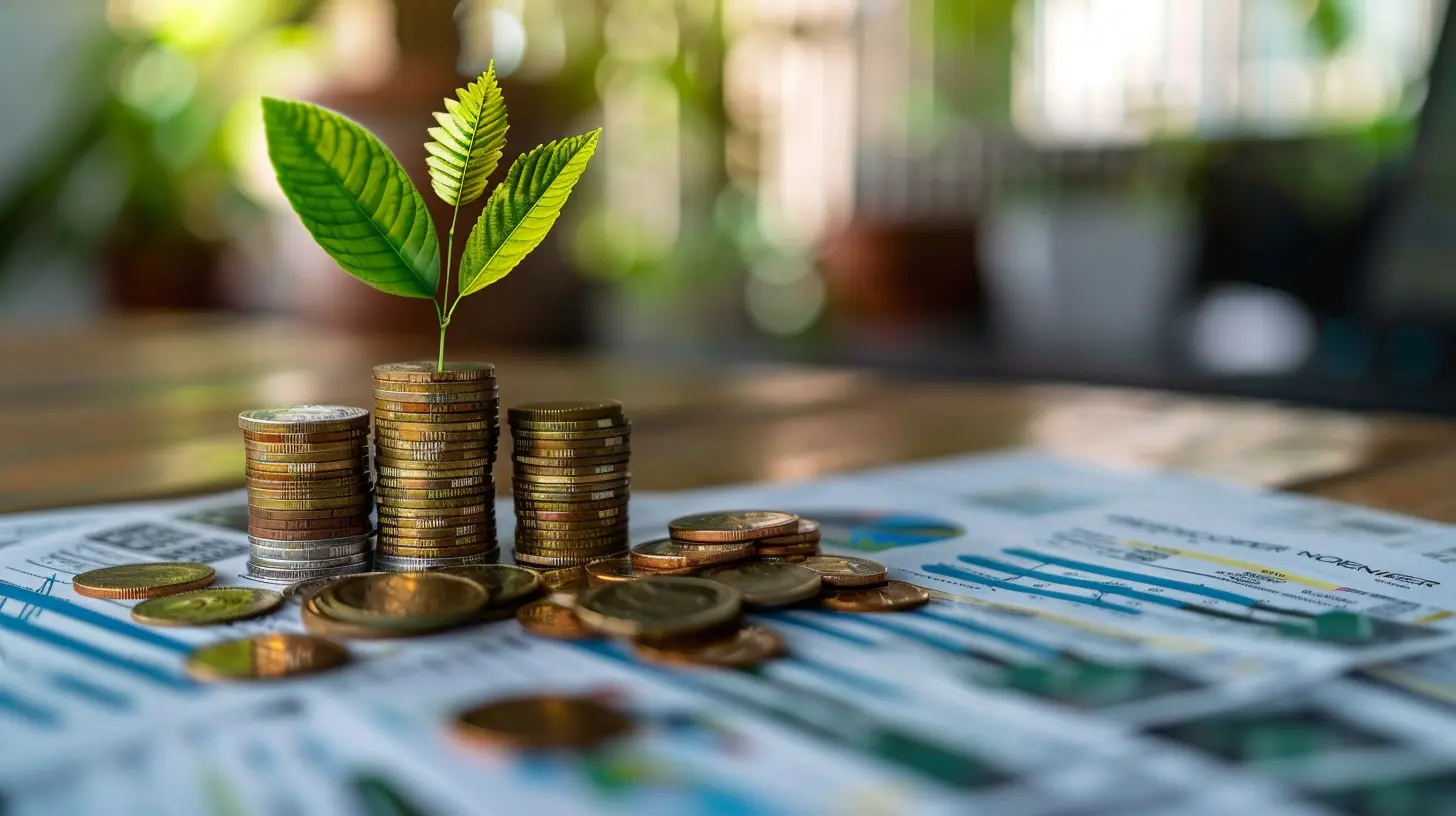Environmental Risks: How ESG Factors Affect Your Investments
6 April 2025
Introduction
Investing isn't just about crunching numbers and chasing profits anymore. Today, there's a growing awareness that factors beyond financial statements—such as environmental risks—can have a significant impact on your portfolio. Enter ESG investing—a strategy where Environmental, Social, and Governance (ESG) factors play a crucial role in investment decisions.
But how exactly do environmental risks shape your investments? Should you be concerned about climate change, pollution, or deforestation when picking stocks? Let's dive in and break it all down.

What Are ESG Factors?
Before we get into environmental risks, let's quickly define ESG:- Environmental (E): This includes climate change, carbon emissions, water usage, pollution, and biodiversity.
- Social (S): It covers issues like human rights, labor standards, diversity, and community relations.
- Governance (G): Focuses on corporate ethics, transparency, executive pay, and board diversity.
For this article, we’re zoning in on the "E" in ESG—Environmental risks.

The Growing Importance of ESG in Investing
Gone are the days when ESG investing was dismissed as a niche strategy. With climate disasters, rising global temperatures, and governments enforcing stricter regulations, investors can no longer afford to ignore environmental risks.Major financial institutions, pension funds, and even retail investors are increasingly considering sustainability metrics when making investment decisions. Why? Because businesses that neglect environmental concerns face not only ethical scrutiny but also huge financial risks. 
Key Environmental Risks That Impact Investments
1. Climate Change & Global Warming
Climate change isn't just an environmental issue—it’s an economic one. Increasing global temperatures lead to more frequent natural disasters like hurricanes, wildfires, and floods. These events disrupt industries, destroy infrastructure, and hinder economic growth.For instance, insurance companies are particularly vulnerable. If wildfires or hurricanes become more frequent and severe, insurers face huge losses from damage payouts. Similarly, real estate markets in flood-prone areas could collapse, leaving investors with devalued properties.
2. Carbon Emissions & Regulatory Risks
Governments worldwide are cracking down on companies with high carbon footprints. Stricter environmental laws, carbon taxes, and emission reduction targets are becoming the new normal.If a company heavily relies on fossil fuels or neglects to reduce its carbon emissions, it could face hefty fines or even be forced to shut operations. Investors holding shares in such companies might see declining stock values or lower profit margins.
3. Resource Depletion & Water Scarcity
Natural resources aren’t infinite. Industries like mining, agriculture, and manufacturing rely heavily on water and raw materials. When these resources become scarce, production costs skyrocket.For example, consider a beverage company that depends on a steady water supply. If it's operating in a drought-prone region, water restrictions could hinder production, slashing profits and causing stock prices to plummet.
4. Biodiversity Loss & Deforestation
Deforestation and biodiversity loss may not seem like direct investment risks, but they can be. When ecosystems collapse, industries that rely on natural resources—such as agriculture, pharmaceuticals, and tourism—face disruptions.Take palm oil producers as an example. Companies responsible for large-scale deforestation may face bans, lawsuits, or consumer backlash, ultimately impacting revenues and investor confidence.
5. Waste Management & Pollution
Environmental pollution is a growing concern, with governments imposing stricter waste management regulations. Companies that fail to manage waste properly might get fined, lose licenses, or suffer reputational damage.For instance, oil spills not only harm marine life but also cause stock prices of responsible companies to dip significantly. Investors holding shares in such firms might find themselves in troubled waters—literally. 
How Environmental Risks Affect Different Investment Assets
1. Stocks & Equities
The stock market reacts quickly to environmental news. Companies caught in environmental scandals often see their stock prices tumble. Investors who prioritize ESG-friendly stocks may see long-term, stable returns compared to those investing in environmentally risky companies.2. Bonds & Fixed Income Assets
Government and corporate bonds are also affected by environmental risks. Countries vulnerable to climate disasters may struggle with economic stability, making their sovereign bonds less attractive. Similarly, companies failing ESG standards may see declining credit ratings, leading to higher borrowing costs.3. Real Estate
If rising sea levels threaten coastal cities, properties in those areas may lose value. Investors in real estate need to consider environmental risks before committing to long-term investments.4. Commodities
Natural resource scarcity—like declining oil reserves or water shortages—directly impacts commodity prices. Investors in commodities must assess how climate change and environmental policies affect supply and demand.Why ESG-Friendly Investments Make Financial Sense
1. Lower Regulatory Risks
ESG-conscious companies are better prepared for changing environmental regulations, reducing the risk of fines, lawsuits, or policy changes that could hurt profits.2. Enhanced Brand Reputation
Companies with strong ESG commitments enjoy better customer and investor trust, leading to higher brand loyalty and, ultimately, better stock performance.3. Long-Term Stability & Growth
Sustainable businesses are better equipped to adapt to changing environmental conditions, ensuring long-term profitability and resilience against future risks.4. Access to Green Investment Funds
With the rise of ESG-focused funds, companies that align with sustainability goals attract more investments from institutions prioritizing ethical asset allocation.How to Incorporate ESG into Your Investment Strategy
1. Research ESG Ratings
Several organizations rate companies based on their ESG performance (such as MSCI, Sustainalytics, and Morningstar). Check these ratings before investing.2. Invest in ESG-Focused Funds
Eco-friendly mutual funds, ETFs, and green bonds are excellent ways to invest in companies committed to sustainability.3. Diversify Your Portfolio
Don’t put all your eggs in one basket. Spread your investments across industries and geographies to minimize exposure to environmental risks.4. Stay Updated on Regulations
Governments frequently update environmental policies. Keeping track of these changes can help you anticipate risks and make informed investment decisions.Final Thoughts
Environmental risks aren’t just buzzwords—they have real financial consequences. Whether it’s climate change, pollution, or resource depletion, ESG factors play a vital role in shaping investment outcomes.By incorporating sustainable investments into your portfolio, you’re not just protecting the planet—you’re also safeguarding your financial future. After all, investing in a greener world is investing in a profitable tomorrow.
all images in this post were generated using AI tools
Category:
Investment RisksAuthor:

Yasmin McGee
Discussion
rate this article
5 comments
Esme Bryant
Understanding ESG is crucial; it directly impacts investment stability and returns.
April 30, 2025 at 4:51 AM

Yasmin McGee
Thank you! Indeed, ESG factors are pivotal in assessing long-term investment viability and risk management.
Thalor Franklin
This article is a fantastic reminder of the importance of considering ESG factors in investment decisions. By prioritizing environmental, social, and governance issues, we can build a more sustainable future while also achieving strong financial returns. Thank you for shedding light on such a crucial topic!
April 16, 2025 at 11:51 AM

Yasmin McGee
Thank you for your insightful comment! I'm glad the article resonated with you on the importance of ESG factors in investing. Together, we can drive positive change while achieving financial success.
Bailey Fisher
In the dance of dollars and green, Where nature's whispers shape the scene, ESG unveils the risks we face, Guiding investments with sustainable grace. In every choice, let conscience steer, For the earth's future holds our greatest treasure dear.
April 12, 2025 at 11:20 AM

Yasmin McGee
Thank you for your poetic reflection! It beautifully captures the essence of how ESG factors guide responsible investing for a sustainable future.
Lara Good
This article beautifully highlights the crucial intersection of finance and sustainability. Understanding ESG factors not only empowers investors to make informed decisions but also fosters a responsible approach to wealth creation. Thank you for shedding light on such an important topic for our future.
April 10, 2025 at 6:58 PM

Yasmin McGee
Thank you for your kind words! I'm glad you found the article helpful in understanding the vital link between ESG factors and responsible investing.
Greyson McInerney
ESG factors are no longer optional in investing; they can significantly impact performance and risk. Ignoring environmental risks could jeopardize returns and stakeholder trust. It’s essential for investors to integrate ESG considerations into their strategies moving forward.
April 8, 2025 at 8:50 PM

Yasmin McGee
Thank you for your insight! I completely agree—integrating ESG factors is crucial for sustainable investing and long-term performance. Stakeholder trust and risk management are more important than ever.




